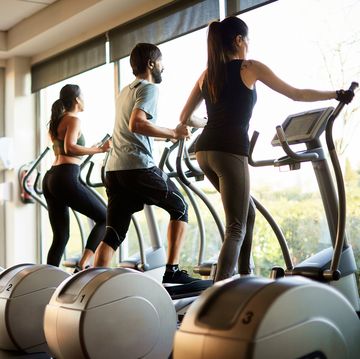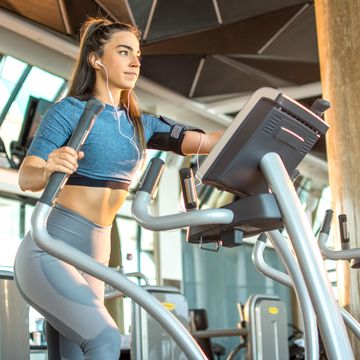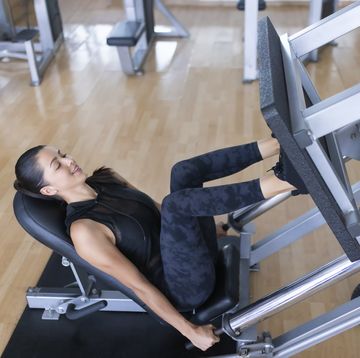If you’re a runner who spends time in the gym, chances are you’re logging more miles on the treadmill than any other cardio machine. But the elliptical – also known as the cross trainer – is also a great piece of cross training equipment for runners and, if you’re smart, you'll be able to weave both into your workout routine.
What are the benefits of running on a treadmill?
It's like running outdoors – but not
The best reason to use the treadmill is the most obvious: it mimics that natural movement of running outside, without subjecting you to the elements. 'Treadmills are also the most honest machines on the planet,' says David Siik, senior manager of running and creator of Precision Running at Equinox in Los Angeles. 'If you input nine miles per hour, it is going to make you go nine miles per hour until you step off. That honesty and the ability to microprogram your speed, incline, and time creates a form of accountability that is so healthy and so rewarding.'
Treadmill running put less pressure on the body
On the treadmill, your body also experiences a little less impact than it would on the pavement, which can keep your joints feeling happy. That said, your body still feels some impact on the treadmill, which isn't a bad thing. 'The healthy impact from a treadmill is so important in maintaining bone density as you age,' explains Siik. And according to research from the University of Missouri, running may actually have more of an impact on building stronger bones than resistance training.
Running also causes what Siik calls a 'natural reaction,' where your infrastructure – your muscle and cartilage – is provoked to stay strong. This includes your upper body, even though the process of running itself doesn't put a huge amount of stress on this area.
Treadmill running can help you lose weight
If losing weight is your goal, treadmill running is a great activity to slot into your routine. Running a 10-minute mile burns about 9.8 METs – that is, the 'metabolic equivalent' for a task, which is an estimate of how much energy the body uses during physical activity. (For context, sitting still equates to just one MET.) The same 68kg person would burn around 668 calories per hour running, for example, but around 341 calories per hour using the elliptical at a moderate effort.
Of course, there’s a flip side – and a reason why the treadmill is sometimes called the 'dreadmill'. 'If you don’t have a plan or a coach to guide you, going nowhere fast can be boring without that engagement in your workout,' says Siik. And running can be hard! It can take a lot of work to push yourself forward on the treadmill, even with the moving belt, which can be discouraging to some people.
When should runners use the treadmill?
If you’re using running for fitness, working out on the treadmill three to four days a week can be a game-changer in terms of your strength, stamina and body composition. And if you’re training for a race, two to three treadmill days is a great way to log runs with more hands-on control in terms of your pace and incline. 'The treadmill can take you to limits far beyond what an elliptical can, and push you to do more work,' says Siik. 'The amount of energy it takes to push off the ground to fight gravity is very big.'
What are the benefits of using an elliptical?
The elliptical is kinder to your joints
Given the above, you might dismiss the elliptical as something that offers an easier workout than running. On the whole, this is true – but that's a good thing. 'The elliptical can provide a lower impact workout for runners, because you’re constantly connected to the pedals, causing less strain on the knees and joints,' says Lee Wratislaw, a certified personal trainer for Gold’s Gym AMP app. This means that using the elliptical can save your lower body joints from a lot of wear and tear, and minimise your risk of overuse injuries that running can bring about.
The elliptical works your whole body
Another big win is that the elliptical gives you a better full body workout than the treadmill. 'Pushing and pulling the handles can provide a challenge for the upper body, and you’re really engaging your core to balance the movements between your upper and lower body,' says Wratislaw. 'Changing the incline and resistance settings can be a great tool for targeting different areas of the lower body.'
Thanks to the circular motion of the pedals, the elliptical also allows you to stride backwards, which can bring other physiological benefits. 'Pedalling in reverse can be an effective way to target the hamstrings, while increasing the incline can bring the focus to the glutes,' adds Wratislaw. 'All of these areas are important for runners to work on.'
You can adjust the intensity
As highlighted earlier, you burn about half the amount of calories on an elliptical compared to what you can burn on a treadmill in the same amount of time, though, if you go by METs. But on an elliptical, you’re still working harder than you think – and you can always add intensity to your cross training workout. 'If you adjust your intensity output, you can really increase the calorie burning effects of an elliptical,' says Wratislaw. However, it's important to remember that there's much more to training than burning calories, and most machines inaccurately estimate calorie burn anyway.
A drawback to the elliptical is that it moves in a locked pattern, so you can’t use it to focus on running form. 'Runners who are training for a race will want to focus more of their time on a treadmill or outdoors to improve their running technique, because they won’t achieve that on the elliptical,' says Wratislaw. And, as with the treadmill, a steady-state session on the elliptical can feel boring and like you’re just spinning your wheels.
When should runners use the elliptical?
While the elliptical can’t replace running, using this piece of equipment can seriously benefit runners – especially those who are injured or overtired. 'The elliptical offers a lower impact experience, giving you a break on your joints when you need it,' says Siik. 'Also, variety is good for you! Moving the body a little differently helps to create some balance.'
'The elliptical can also be used as active recovery and low impact conditioning for a runner who may need a rest day from their running routine,' says Wratislaw. 'Incorporating the elliptical will allow you to still reap the cardiovascular benefits of a tough workout while providing lower impact. That can be a great tool for runners who want to prevent injury or just mix up their fitness routine.'

















